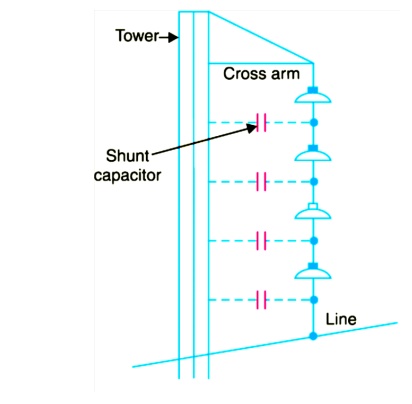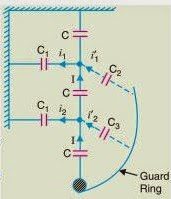String Efficiency
The suspension insulator is the one which consists of a number of porcelain discs connected in series by metal links in the form of a string.
The voltage applied across the string of the suspension insulators is not uniformly distributed across the various discs, i.e. the disc nearest to the line conductor has much higher potential than the other discs. This unequal potential distribution is undesirable and it is usually expressed in terms of string efficiency. Therefore, the string efficiency of the suspension type insulator is defined as follows −
“The ratio of voltage across the whole string to the product of the voltage across the disc nearest to the conductor and the number of discs in the string is known as string efficiency.”
Where, n is the number of discs in the string of suspension insulator.
Hence, from the definition of the string efficiency, it is clear that the greater the string efficiency, the more uniform is the potential distribution across the string. In ideal case, the string efficiency is 100% for which the voltage across each disc will be exactly the same. However, it is impossible to achieve 100% string efficiency.
he string efficiency is defined as the ratio of voltage across the string to the product of the number of strings and the voltage across the unit adjacent string.
 Where, V = voltage across the whole string
Where, V = voltage across the whole string
n = number of insulator discs in the string
v1 = voltage across the lowest unit connected to the line conductor.
Significance of String Efficiency :
It is essential to find the string efficiency of transmission line insulators as it suggests the voltage distribution along with each disc of the string insulator.
If voltage distribution is uniform along with the discs of the string insulator, then the efficiency is high and thus each disc of the insulator is fully and equally utilized. This also means that all the discs in the string will experience an equal amount of stress, thereby increasing the life span of the string.
Methods of Improving String Efficiency
As we know, the potential distribution in a string of suspension insulators is not uniform, i.e. the highest potential appears across the insulator disc nearest to the line conductor and decreases progressively as the cross-arm is approached.
If the insulation of the disc nearest to the line conductor breaks down, the breakdown of the other discs will take place in succession. Therefore, it is required to equalise the voltage across the various discs of the string, i.e., needs to improve the string efficiency.
The following methods are employed for improving the string efficiency of a suspension type insulator −
By using the longer cross-arms
By grading the insulators
By using a guard ring
(I) Using Longer Cross Arms
It is clear from the above mathematical expression of string efficiency that the value of string efficiency depends upon the value of k. Lesser the value of k, the greater is the string efficiency. As the value of k approaches to zero, the string efficiency approaches to 100%. The value of k can be decreased by reducing the shunt capacitance. In order to decrease the shunt capacitance, the distance between the insulator string and the tower should be increased, i.e. longer cross-arms should be used. However, there is a limit in increasing the length of cross-arms due to economic considerations.By Using Longer Cross-Arms
The value of string efficiency depends upon the value of K i.e., ratio of shunt capacitance to mutual capacitance. The lesser the value of K, the greater is the string efficiency and more uniform is the voltage distribution. The value of K can be decreased by reducing the shunt capacitance. In order to reduce shunt capacitance, the distance of conductor from tower must be increased i.e., longer cross-arms should be used. However, limitations of cost and strength of tower do not allow the use of very long cross-arms. In practice, K = 0·1 is the limit that can be achieved by this method.

II) By Grading The Insulators
In this method, insulators of different dimensions are so chosen that each has a different capacitance. The insulators are capacitance graded i.e. they are assembled in the string in such a way that the top unit has the minimum capacitance, increasing progressively as the bottom unit (i.e., nearest to conductor) is reached. Since voltage is inversely proportional to capacitance, this method tends to equalize the potential distribution across the units in the string. This method has the disadvantage that a large number of different-sized insulators are required. However, good results can be obtained by using standard insulators for most of the string and larger units for that near to the line conductor.
The potential across each unit in a string can be equalized by using a guard ring which is a metal ring electrically connected to the conductor and surrounding the bottom insulator as shown in the Figure below.The guard ring introduces capacitance between metal fittings and the line conductor.The guard ring is contoured in such a way that shunt capacitance currents i1, i2 etc. are equal to metal fitting line capacitance currents i′1, i′2 etc.The result is that same charging current I flows through each unit of string.Consequently, there will be uniform potential distribution across the units.







